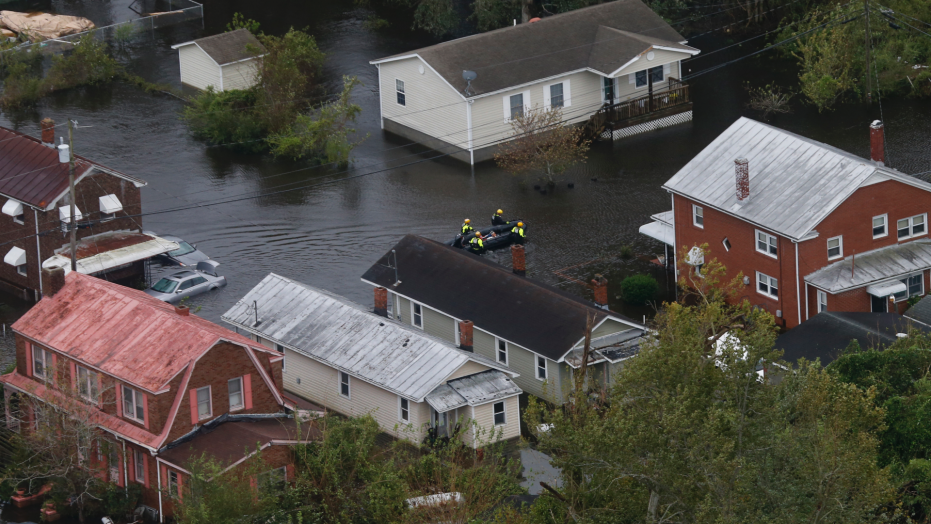The number of Americans with flood insurance is on the rise, yet Hurricane Florence is likely to make it painfully clear that too many homeowners in the Carolinas and other vulnerable regions remain unprotected. .
An analysis of federal flood insurance records by The Associated Press found there were roughly 5.1 million active flood insurance policies in the U.S. as of July 31, up from 4.94 million a year earlier.
The Carolinas had modest gains — a 2.5 percent increase in South Carolina and a 3.5 percent increase in North Carolina.
But large gaps in coverage remain. South Carolina is the second-highest insured state for flooding, with roughly 65 percent of properties in flood hazard areas insured. But in North Carolina, where forecasters say the storm might bring the most destructive round of flooding in state history, flood coverage is less common, with only 35 percent of at-risk properties insured.
After blowing ashore as a hurricane with 90 mph (145 kph) winds, Florence virtually parked itself much of the weekend atop the Carolinas as it pulled warm water from the ocean and hurled it onshore. Storm surges, flash floods and winds scattered destruction widely.
Most of the gains observed in the federal flood insurance data over the past 12 months occurred in Texas, with about 145,000 new policies. Insurance experts say that Hurricane Harvey, which brought tremendous flood damage to Texas and Louisiana late last summer, helped increase public awareness that homeowners need flood insurance.
“That’s terrific. Nothing sells flood insurance like a storm,” said Robert Hunter, who ran the National Flood Insurance Program in the 1970s.
Still, federal officials say there are too many Americans in vulnerable areas who lack flood insurance — even after storms such as Sandy, Matthew and Harvey caused widespread property damage and financial losses with storm surge and rainfall. A look at the five-year and 10-year trends shows a decline in the number of flood insurance policies nationwide.
Property insurance typically doesn’t cover flooding, and flood insurance remains by and large a federal government program run by the Federal Emergency Management Agency, or FEMA.
FEMA requires most homeowners with mortgages living in certain designated areas to buy flood insurance. But there are numerous neighborhoods across the U.S. that are vulnerable to flooding but where insurance isn’t mandatory and many residents choose not to enroll — sometimes with dire consequences.
In the five years before Hurricane Harvey walloped Houston last year, for instance, the number of homes covered in the city dropped 11 percent. The monster storm ended up flooding more than 150,000 homes in the area, leaving many people digging into their savings to repair their houses.
Data show that even with the increase in flood insurance coverage over the past year, the number of homes covered is down 3 percent in North Carolina and 6 percent South Carolina compared with five years ago.
Researchers and insurance experts say many Americans choose not to get flood insurance because of a belief that flooding will not happen to them, or if it does, federal disaster assistance cover their losses.
But federal disaster relief typically consists of low-interest loans — money that must be repaid. The maximum amount of disaster assistance available to an individual or household is $34,000, which is typically not enough to cover repairs caused by flooding. The average damage caused by flooding during Harvey was around $80,000, according to the Texas Department of Insurance.
“We have been working for the last couple years to close the insurance gap, but still not near enough people have necessary coverage. We still have a lot of work to do,” said David Maursted, the current director of the government’s flood insurance program, in a conference call with reporters on Thursday.
Because Hurricane Florence hit the Carolina coast as a less powerful Category 1 storm, damages are expected to be less severe than originally estimated. Property data company CoreLogic estimates the storm surge and wind from Florence will cause roughly $3 billion to $5 billion in damages.
But the potential property damage in the Carolinas could once again strain the financial health of the nation’s flood insurance program.
Starting with Katrina in 2005, a series of catastrophic storms have forced the program to pay out billions of dollars more in claims than it receives in premiums. Last year, the damages from Hurricanes Harvey and Irma caused the program to reach its $30.5 billion statutory limit on borrowing.
In renewing the flood insurance program’s mandate last year, Congress forgave roughly $16 billion in the program’s debt. But the program is still roughly $20.5 billion in the red, according to FEMA.
Maursted said NFIP insurance companies are already deploying claims agents and adjusters to the area and they do not expect any delays in processing claims. Policyholders who have flood insurance should file a claim with their insurance company as soon as they feel it’s safe enough to do so.
(AP)











